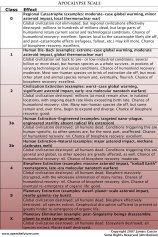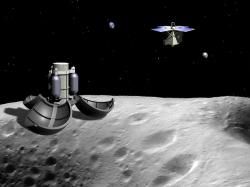Using materials native to space, instead of hauling everything from Earth, is crucial to future efforts at large-scale space industrialization and colonization. At that time we will be using technologies far in advance of today’s, but even now we can see the technology developing for use here on earth.
There are a myriad of materials we would like to process, including dirty organic-laden ice on comets and some asteroids, subsurface ice and the atmosphere of Mars, platinum-rich unoxidized nickel-iron metal regoliths on asteroids, etc. There are an even wider array of materials we would like to make. The first and most important is propellant, but eventually we want a wide array of manufacturing and construction inputs, including complex polymers like Kevlar and graphite epoxies for strong tethers.
The advantages of native propellant can be seen in two recent mission proposals. In several Mars mission proposals[1], H2 from Earth or Martian water is chemically processed with CO2 from the Martian atmosphere, making CH4 and O2 propellants for operations on Mars and the return trip to Earth. Even bringing H2 from Earth, this scheme can reduce the propellant mass to be launched from Earth by over 75%. Similarly, I have described a system that converts cometary or asteroidal ice into a cylindrical, zero-tank-mass thermal rocket. This can be used to transport large interplanetary payloads, including the valuable organic and volatile ices themselves into high Earth and Martian orbits.
Earthside chemical plants are usually far too heavy to launch on rockets into deep space. An important benchmarks for plants in space is the thruput mass/equipment mass, or mass thruput ratio (MTR). At first glance, it would seem that almost any system with MTR>1 would be worthwhile, but in real projects risk must be reduced through redundancy, time cost of money must be accounted for, equipment launched from earth must be affordable in the first place (typically
A special consideration is the operation of chemical reactors in microgravity. So far all chemical reactors used in space — mostly rocket engines, and various kinds of life support equipment in space stations — have been designed for microgravity. However, Earthside chemical plants incorporate many processes that use gravity, and must be redesigned. Microgravity may be advantageous for some kinds of reactions; this is an active area of research. On moons or other plants, we are confronted with various fixed low levels of gravity that may be difficult to design for. With a spinning tethered satellite in free space, we can get the best of all worlds: microgravity, Earth gravity, or even hypergravity where desired.
A bigger challenge is developing chemical reactors that are small enough to launch on rockets, have high enough thruput to be affordable, and are flexible enough to produce the wide variety of products needed for space industry. A long-range ideal strategy is K. Eric Drexler’s nanotechnology [2]. In this scenario small “techno-ribosomes”, designed and built molecule by molecule, would use organic material in space to reproduce themselves and produce useful product. An intermediate technology, under experimental research today, uses lithography techniques on the nanometer scale to produce designer catalysts and microreactors. Lithography, the technique which has made possible the rapid improvement in computers since 1970, has moved into the deep submicron scale in the laboratory, and will soon be moving there commercially. Lab research is also applying lithography to the chemical industry, where it might enable breakthroughs to rival those it produced in electronics.
Tim May has described nanolithography that uses linear arrays of 1e4-1e5 AFM’s that would scan a chip and fill in detail to 10 nm resolution or better. Elsewhere I have described a class of self-organizing molecules called _nanoresists_, which make possible the use of e-beams down to the 1 nm scale. Nanoresists range from ablatable films, to polymers, to biological structures. A wide variety of other nanolithography techniques are described in [4,5,6]. Small-scale lithography not only improves the feature density of existing devices, it also makes possible a wide variety of new devices that take advantage of quantum effects: glowing nanopore silicon, quantum dots (“designer atoms” with programmable electronic and optical properties), tunneling magnets, squeezed lasers, etc. Most important for our purposes, they make possible to mass production of tiny chemical reactors and designer catalysts. Lithography has been used to fabricate a series of catalytic towers on a chip [3]. The towers consist of alternating layers of SiO2 4.1 nm thick and Ni 2–10 nm thick. The deposition process achieves nearly one atom thickness control for both SiO2 and Ni. Previously it was thought that positioning in three dimensions was required for good catalysis, but this catalyst’s nanoscale 1-d surface force reagants into the proper binding pattern. It achieved six times the reaction rate of traditional cluster catalysts on the hydrogenolysis of ethane to methane, C2H6 + H2 –> 2CH4. The thickness of the nickel and silicon dioxide layers can be varied to match the size of molecules to be reacted.
Catalysts need to have structures precisely designed to trap certain kinds of molecules, let others flow through, and keep still others out, all without getting clogged or poisoned. Currently these catalysts are built by growing crystals of the right spacing in bulk. Sometimes catalysts come from biotech, for example the bacteria used to grow the corn syrup in soda pop. Within this millenium (only 7.1 years left!) we will start to see catalysts built by new techniques of nanolithography, including AFM machining, AFM arrays and nanoresists Catalysts are critical to the oil industry, the chemical industry and to pollution control — the worldwide market is in the $100’s of billions per year and growing rapidly.
There is a also big market for micron-size chemical reactors. We may one day see the flexible chemical plant, with hundreds of nanoscale reactors on a chip, the channels between them reprogrammed via switchable valves, much as the circuits on a chip can be reprogrammed via transitors. Even a more modest, large version of such a plant could have a wide variety of uses.
Their first use may be in artificial organs to produce various biological molecules. For example, they might replace or augment the functionality of the kidneys, pancreas, liver, thyroid gland, etc. They might produce psychoactive chemicals inside the blood-brain barrier, for example dopamine to reverse Parkinson’s disease. Biological and mechanical chemical reactors might work together, the first produced via metaboic engineering[7], the second via nanolithography.
After microreactors, metabolic engineering, and nanoscale catalysts have been developed for use on Earth, they will spin off for use in space. Microplants in space could manufacture propellant, a wide variety of industrial inputs and perform life support functions more efficiently. Over 95% of the mass we now launch into space could be replaced by these materials produced from comets, asteroids, Mars, etc. Even if Drexler’s self-replicating assemblers are a long time in coming, nanolithographed tiny chemical reactors could open up the solar system.
====================
ref:
[1] _Case for Mars_ conference proceedings, Zubrin et. al.
papers on “Mars Direct“
[2] K. Eric Drexler, _Nanosystems_, John Wiley & Sons 1992
[3] Science 20 Nov. 1992, pg. 1337.
[4] Ferry et. al. eds., _Granular Nanoelectronics_, Plenum Press 1991
[5] Geis & Angus, “Diamond Film Semiconductors”, Sci. Am. 10/92
[6] ???, “Quantum Dots”, Sci. Am. 1/93
[7] Science 21 June 1991, pgs. 1668, 1675.
These microreactors have a multiplicity of uses in various Lifeboat-relevant endeavors, including making human beings more resistant against harmful diseases. Molecular nanotechnology, rather than being long-range, is likely to be developed between 2010 and 2020. The Center for Responsible Nanotechnology has written at length in favor of this view.


